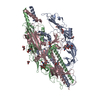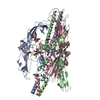[English] 日本語
 Yorodumi
Yorodumi- PDB-8yg8: The early intermediate structure of baculovirus fusion protein GP64 -
+ Open data
Open data
- Basic information
Basic information
| Entry | Database: PDB / ID: 8yg8 | |||||||||||||||||||||||||||||||||||||||||||||||||||||||||||||||
|---|---|---|---|---|---|---|---|---|---|---|---|---|---|---|---|---|---|---|---|---|---|---|---|---|---|---|---|---|---|---|---|---|---|---|---|---|---|---|---|---|---|---|---|---|---|---|---|---|---|---|---|---|---|---|---|---|---|---|---|---|---|---|---|---|
| Title | The early intermediate structure of baculovirus fusion protein GP64 | |||||||||||||||||||||||||||||||||||||||||||||||||||||||||||||||
 Components Components | Major envelope glycoprotein | |||||||||||||||||||||||||||||||||||||||||||||||||||||||||||||||
 Keywords Keywords | STRUCTURAL PROTEIN | |||||||||||||||||||||||||||||||||||||||||||||||||||||||||||||||
| Function / homology |  Function and homology information Function and homology informationsymbiont-mediated perturbation of host process / membrane fusion involved in viral entry into host cell / viral budding from plasma membrane / fusion of virus membrane with host endosome membrane / viral envelope / symbiont entry into host cell / host cell plasma membrane / virion membrane / identical protein binding / membrane Similarity search - Function | |||||||||||||||||||||||||||||||||||||||||||||||||||||||||||||||
| Biological species |  Autographa californica nucleopolyhedrovirus Autographa californica nucleopolyhedrovirus | |||||||||||||||||||||||||||||||||||||||||||||||||||||||||||||||
| Method | ELECTRON MICROSCOPY / single particle reconstruction / cryo EM / Resolution: 2.97 Å | |||||||||||||||||||||||||||||||||||||||||||||||||||||||||||||||
 Authors Authors | Du, D. / Guo, J. / Li, S. | |||||||||||||||||||||||||||||||||||||||||||||||||||||||||||||||
| Funding support |  China, 1items China, 1items
| |||||||||||||||||||||||||||||||||||||||||||||||||||||||||||||||
 Citation Citation |  Journal: Nat Commun / Year: 2024 Journal: Nat Commun / Year: 2024Title: Structural transition of GP64 triggered by a pH-sensitive multi-histidine switch. Authors: Jinliang Guo / Shangrong Li / Lisha Bai / Huimin Zhao / Wenyu Shang / Zhaojun Zhong / Tuerxunjiang Maimaiti / Xueyan Gao / Ning Ji / Yanjie Chao / Zhaofei Li / Dijun Du /  Abstract: The fusion of viruses with cellular membranes is a critical step in the life cycle of enveloped viruses. This process is facilitated by viral fusion proteins, many of which are conformationally pH- ...The fusion of viruses with cellular membranes is a critical step in the life cycle of enveloped viruses. This process is facilitated by viral fusion proteins, many of which are conformationally pH-sensitive. The specifics of how changes in pH initiate this fusion have remained largely elusive. This study presents the cryo-electron microscopy (cryo-EM) structures of a prototype class III fusion protein, GP64, in its prefusion and early intermediate states, revealing the structural intermediates accompanying the membrane fusion process. The structures identify the involvement of a pH-sensitive switch, comprising H23, H245, and H304, in sensing the low pH that triggers the initial step of membrane fusion. The pH sensing role of this switch is corroborated by assays of cell-cell syncytium formation and dual dye-labeling. The findings demonstrate that coordination between multiple histidine residues acts as a pH sensor and activator. The involvement of a multi-histidine switch in viral fusion is applicable to fusogens of human-infecting thogotoviruses and other viruses, which could lead to strategies for developing anti-viral therapies and vaccines. | |||||||||||||||||||||||||||||||||||||||||||||||||||||||||||||||
| History |
|
- Structure visualization
Structure visualization
| Structure viewer | Molecule:  Molmil Molmil Jmol/JSmol Jmol/JSmol |
|---|
- Downloads & links
Downloads & links
- Download
Download
| PDBx/mmCIF format |  8yg8.cif.gz 8yg8.cif.gz | 257 KB | Display |  PDBx/mmCIF format PDBx/mmCIF format |
|---|---|---|---|---|
| PDB format |  pdb8yg8.ent.gz pdb8yg8.ent.gz | 209.4 KB | Display |  PDB format PDB format |
| PDBx/mmJSON format |  8yg8.json.gz 8yg8.json.gz | Tree view |  PDBx/mmJSON format PDBx/mmJSON format | |
| Others |  Other downloads Other downloads |
-Validation report
| Summary document |  8yg8_validation.pdf.gz 8yg8_validation.pdf.gz | 543.7 KB | Display |  wwPDB validaton report wwPDB validaton report |
|---|---|---|---|---|
| Full document |  8yg8_full_validation.pdf.gz 8yg8_full_validation.pdf.gz | 563.2 KB | Display | |
| Data in XML |  8yg8_validation.xml.gz 8yg8_validation.xml.gz | 29.6 KB | Display | |
| Data in CIF |  8yg8_validation.cif.gz 8yg8_validation.cif.gz | 44.5 KB | Display | |
| Arichive directory |  https://data.pdbj.org/pub/pdb/validation_reports/yg/8yg8 https://data.pdbj.org/pub/pdb/validation_reports/yg/8yg8 ftp://data.pdbj.org/pub/pdb/validation_reports/yg/8yg8 ftp://data.pdbj.org/pub/pdb/validation_reports/yg/8yg8 | HTTPS FTP |
-Related structure data
| Related structure data |  39238MC  8yg6C M: map data used to model this data C: citing same article ( |
|---|---|
| Similar structure data | Similarity search - Function & homology  F&H Search F&H Search |
- Links
Links
- Assembly
Assembly
| Deposited unit | 
|
|---|---|
| 1 |
|
- Components
Components
| #1: Protein | Mass: 53338.871 Da / Num. of mol.: 3 Source method: isolated from a genetically manipulated source Source: (gene. exp.)  Autographa californica nucleopolyhedrovirus Autographa californica nucleopolyhedrovirusGene: GP64, GP67, ORF128 / Production host:  #2: Polysaccharide | #3: Sugar | ChemComp-NAG / Has ligand of interest | N | Has protein modification | Y | |
|---|
-Experimental details
-Experiment
| Experiment | Method: ELECTRON MICROSCOPY |
|---|---|
| EM experiment | Aggregation state: PARTICLE / 3D reconstruction method: single particle reconstruction |
- Sample preparation
Sample preparation
| Component | Name: GP64 / Type: COMPLEX / Entity ID: #1 / Source: RECOMBINANT |
|---|---|
| Source (natural) | Organism:  Autographa californica nucleopolyhedrovirus Autographa californica nucleopolyhedrovirus |
| Source (recombinant) | Organism:  |
| Buffer solution | pH: 7.5 |
| Specimen | Conc.: 0.8 mg/ml / Embedding applied: NO / Shadowing applied: NO / Staining applied: NO / Vitrification applied: YES |
| Vitrification | Cryogen name: ETHANE / Humidity: 100 % |
- Electron microscopy imaging
Electron microscopy imaging
| Experimental equipment |  Model: Titan Krios / Image courtesy: FEI Company |
|---|---|
| Microscopy | Model: FEI TITAN KRIOS |
| Electron gun | Electron source:  FIELD EMISSION GUN / Accelerating voltage: 300 kV / Illumination mode: FLOOD BEAM FIELD EMISSION GUN / Accelerating voltage: 300 kV / Illumination mode: FLOOD BEAM |
| Electron lens | Mode: BRIGHT FIELD / Nominal defocus max: 2500 nm / Nominal defocus min: 1000 nm |
| Image recording | Electron dose: 60.02 e/Å2 / Film or detector model: FEI FALCON IV (4k x 4k) |
- Processing
Processing
| EM software | Name: PHENIX / Category: model refinement | ||||||||||||||||||||||||
|---|---|---|---|---|---|---|---|---|---|---|---|---|---|---|---|---|---|---|---|---|---|---|---|---|---|
| CTF correction | Type: PHASE FLIPPING ONLY | ||||||||||||||||||||||||
| 3D reconstruction | Resolution: 2.97 Å / Resolution method: FSC 0.143 CUT-OFF / Num. of particles: 70235 / Symmetry type: POINT | ||||||||||||||||||||||||
| Refine LS restraints |
|
 Movie
Movie Controller
Controller



 PDBj
PDBj




